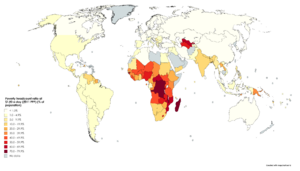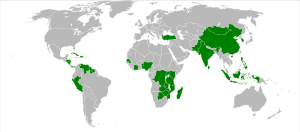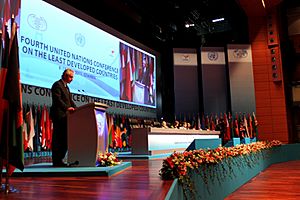Least developed countries facts for kids
The least developed countries (LDCs) are nations that the United Nations says are still developing. They have the lowest scores for things like how well people live and how strong their economy is. The idea of LDCs started in the late 1960s. The UN first listed these countries on November 18, 1971.
To be called a Least Developed Country, a nation must meet three main requirements:
- Poverty: This looks at how much money people earn on average. In 2018, a country was an LDC if its average income per person was less than US$1,025 over three years. To leave the list, it needed to be over US$1,230.
- Weak Human Resources: This means looking at how healthy people are, if they get enough food, and how good their education is. It also checks how many adults can read and write.
- Economic Weakness: This checks if a country's economy is easily hurt. For example, if its farm production changes a lot, or if it relies too much on selling just a few types of goods. It also looks at how many people are affected by natural disasters.
As of December 2020, 46 countries were still on the LDC list. Six countries had improved enough to leave the list between 1994 and 2020. The World Trade Organization (WTO) agrees with the UN's list. They believe that trade rules can help LDCs sell more goods to other countries and attract more investments.
Contents
How Countries Become or Leave the LDC List
The rules for LDCs are checked every three years by a group called the Committee for Development Policy (CDP). This group is part of the United Nations Economic and Social Council (ECOSOC). A country can be removed from the LDC list if it meets the higher standards in two checks in a row.
The United Nations Office of the High Representative for the Least Developed Countries, Landlocked Developing Countries and Small Island Developing States (UN-OHRLLS) helps LDCs. They make sure the UN supports these countries and speaks up for them. In December 2020, 46 countries were on this list.
At a big UN meeting in May 2011, leaders hoped that at least half of the LDC countries would improve enough to leave the list within ten years. By 2018, it was thought that ten or more countries would graduate by 2024. Bangladesh and Djibouti had already met all the requirements in 2018.
Some countries have met the requirements to be an LDC but chose not to be on the list. They questioned if the CDP's information was correct. These include Ghana (which no longer meets the criteria since 1994), Papua New Guinea (since 2009), and Zimbabwe.
Understanding the Terms
It's important to know the difference between "least developed countries" and other terms like "developing countries." Sometimes, people use "less economically developed country" (LEDC). However, to avoid confusion, the term "developing country" is often used instead of "less-developed country." This also helps avoid mixing it up with "landlocked developing country" (LLDC), which means a country with no access to the sea.
In 2018, the UN said that LDCs are countries that meet three main rules. One of these rules is that their average income per person over three years is less than US$1,025.
UN Meetings for LDCs
The United Nations has held five major meetings about LDCs, usually every ten years. The first two were in Paris in 1981 and 1991. The third was in Brussels in 2001.
The fourth UN meeting on LDCs (LDC-IV) took place in Istanbul, Turkey, from May 9 to 13, 2011. The head of the UN, Ban Ki-moon, and nearly 50 prime ministers and heads of state attended. At this meeting, they set a goal to help half of the LDCs improve enough to leave the category by 2022. There was a strong focus on helping these countries make more goods and improve their buildings and roads.
Trade and LDCs
Global trade rules and how they affect LDCs have received a lot of attention. This is especially true because of the Doha Round of World Trade Organization (WTO) talks, which aimed to help developing countries. At a WTO meeting in Hong Kong in 2005, it was agreed that LDCs could sell their goods to U.S. markets without paying taxes or having limits on how much they could sell. This would happen if the trade talks were finished.
However, some groups pointed out that this deal had problems. They said it might not give LDCs full access to markets and could even take away some of the benefits they already had. Because of these issues, some experts called for the Hong Kong deal to be changed.
Dr. Chiedu Osakwe, who worked for the WTO and advised on developing countries, became the WTO's Special Coordinator for LDCs in 1999. He worked with other groups to help LDCs with market access. This means helping them sell their goods more easily in other countries. He also worked on making sure trade rules were fair for developing countries. At a meeting of the G8 countries in Canada, Canadian Prime Minister Jean Chrétien suggested a "Market Access Initiative." This idea was to help the 48 LDCs at the time benefit from "trade-not-aid," meaning they could grow by trading, not just by getting help. The UN's Sustainable Development Goal 14 also supports special treatment for LDCs in WTO talks about fishing subsidies.
List of Countries
As of November 2021, the following 46 countries were still listed as least developed countries by the UN: Afghanistan, Angola, Bangladesh, Benin, Bhutan, Burkina Faso, Burundi, Cambodia, Central African Republic, Chad, Comoros, Democratic Republic of Congo, Djibouti, Eritrea, Ethiopia, Gambia, Guinea, Guinea-Bissau, Haiti, Kiribati, Laos, Lesotho, Liberia, Madagascar, Malawi, Mali, Mauritania, Mozambique, Myanmar, Nepal, Niger, Rwanda, São Tomé and Príncipe, Senegal, Sierra Leone, Solomon Islands, Somalia, South Sudan, Sudan, East Timor, Togo, Tuvalu, Uganda, Tanzania, Yemen, Zambia.
By Continent or Region
There are 33 Least Developed Countries in Africa, nine in Asia, three in Oceania, and one in the Americas.
Here is the list of "least developed countries" by the United Nations. Some of these are also called landlocked developing countries (meaning they have no coast) or Small Island Developing States (small island nations).
- Africa
- Americas
- Asia
- Oceania
Countries That Have Graduated
The Committee for Development Policy checks the three main rules (human assets, economic weakness, and income per person) every three years. For a country to leave the LDC list, it must meet two of the three rules in two checks in a row. The Committee then suggests this to the Economic and Social Council (ECOSOC) for approval.
Since the LDC category started, six countries have improved enough to become "developing countries."
- The first country to graduate was Botswana in 1994.
- Cape Verde followed in 2007.
- Maldives graduated in early 2011.
- Samoa improved in 2014.
- Equatorial Guinea left the list in 2017.
- Vanuatu graduated in December 2020.
The following countries are no longer in the "least developed countries" group:
 Sikkim (became part of India in 1975)
Sikkim (became part of India in 1975) Botswana (graduated in December 1994)
Botswana (graduated in December 1994) Cape Verde (graduated in December 2007)
Cape Verde (graduated in December 2007) Maldives (graduated in January 2011)
Maldives (graduated in January 2011) Samoa (graduated in January 2014)
Samoa (graduated in January 2014) Equatorial Guinea (graduated in June 2017)
Equatorial Guinea (graduated in June 2017) Vanuatu (graduated in December 2020)
Vanuatu (graduated in December 2020)
Countries Expected to Graduate Soon
Many countries are working hard to improve and leave the LDC list.
- Bhutan is expected to graduate on December 13, 2023.
- São Tomé and Príncipe and Solomon Islands will also leave the category in 2024.
- Nepal was chosen to graduate in 2018, but they asked to wait until 2021. This was later pushed back another five years.
- Angola was supposed to graduate in 2021. However, because of economic problems and its reliance on selling raw materials, the preparation time was extended by three years.
- Bangladesh met the requirements twice, in 2018 and 2021. The country will officially graduate from LDC status in November 2026. This is two years later than planned because of the COVID-19 pandemic.
- Laos and Nepal will also graduate in November 2026.
- Cambodia is expected to graduate from LDC status in 2027.
See also
 In Spanish: Países menos desarrollados para niños
In Spanish: Países menos desarrollados para niños
- Development geography
- Development economics
- Economic development
- Extreme poverty
- Failed state
- Group of 77
- Heavily indebted poor countries
- Human Development Index
- Human Poverty Index
- List of countries by GDP (PPP) per capita
- More developed country (MDC), opposite of LDCs
- Newly industrialized country
- Right to development





